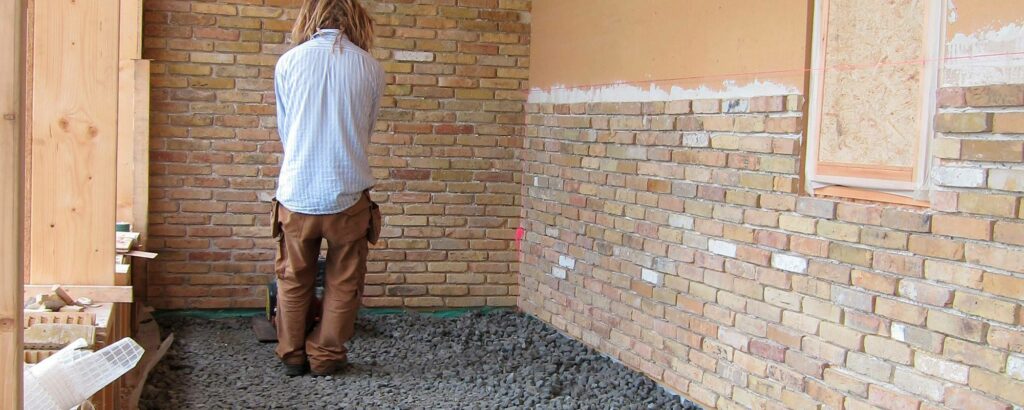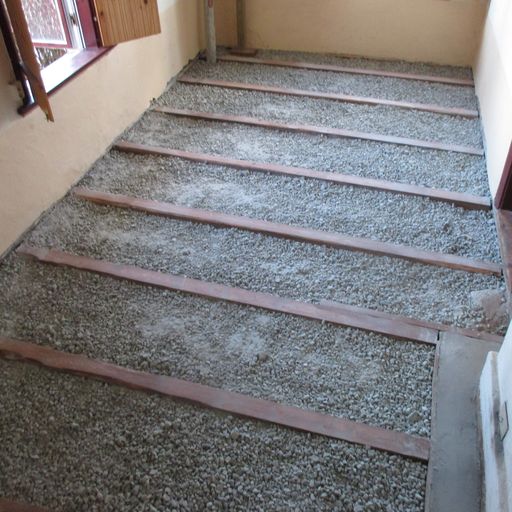Filling material with a wide range of applications
Glass foam gravel is the most ecological and light filling material in its class. The structure of foam glass gravel is porous, making it lightweight, strong and thermally insulating. Foam glass gravel is made of recycled glass and it has a small carbon footprint.
The pieces of foam glass gravel are polygonal with rough fracture surface. Due to the “self-locking” properties it has an extremely high angle of variation – up to 45°. It makes it more stable than round gravel, that in turn makes the material easy to handle and reduces the labour costs.
Its very low mass weight reduces the pressure on lower constructions.
The uses of glass foam gravel in construction
- Insulating and ventilating filling of solid floors,
- draining and heating filling of the surroundings of foundations and outdoor constructions,
- lightweight insulation of ceilings and flat roofs,
- freeze-tolerant and non-sinking insulation.
Glass foam gravel is part of the Nordic eco-label product database.

Product features
- Decreases pressure due to low mass weight,
- Can withstand being walked upon even when not compressed,
- Great load capacity when compressed,
- Heat/cold insulating,
- Great draining and ventilation properties,
- A1 fire rating, M1 emission rating;
- Free from organic materials and sulfur.
Glass foam gravel in underground construction
In floor construction, glass foam gravel acts as a light and insulating filling material, as the water barrier and as a ventilating solution in radon-hazardous areas.
Underfloor piping does not require additional expensive insulation when using foam glass gravel.
Glass foam gravel acts as a filling, insulating and draining material for the external backfill of the basement foundation. It puts ten times less pressure on the basement wall which allows to dimension a lighter and more affordable foundation. As a bonus, the surroundings of the foundation are properly insulated and drained.
In areas with very low load capacity, glass foam gravel can be used to build a compensating foundation. In this case, glass foam gravel is used to replace part of the soil. The weight of the building with the glass foam gravel cannot exceed the total mass of the excavated soil and its pressure on the bearing surface.
Filling of the ceilings
Glass foam gravel is the lightest filling material in its class. It is suitable for new constructions and renovations, where the uneven foundation needs to be filled without putting too much pressure on constructions below. Glass foam gravel is easy to use and thanks to its polygonal shape and fraction, it can be immediately walked upon. This material makes it easier to give necessary inclination for the floors. Floor casting can be done on compressed glass foam gravel without additional works or intermediate layers. Good practice is to put a film layer under the concrete beforehand.
In the renovation of wooden construction objects old and usually organic material between the beams is replaced by glass foam gravel. It does not contain any organic materials and it is bacteria resistant. Additionally, it is rodent- and insect-resistant.
Glass goam gravel has an A1 fire rating and a M1 emission rating. It is produced from recycled glass and it has a small carbon footprint.

Roof construction
Glass foam gravel is used to give inclination to flat roofs and for insulation since it has remarkable insulative properties. Roof construction requires natural ventilation and since glass foam gravel has good ventilating properties, it is very suitable for the task.
The installation of glass foam gravel does not require special training. Regular construction equipment and tools are used.
Glass foam gravel is easy to use and thanks to its polygonal shape and fraction, it can be immediately walked upon. This material makes it easier to give necessary inclination for the roof. Floor casting can be done on compressed glass foam gravel without additional works or intermediate layers. Good practice is to put a film layer under the concrete beforehand.
Green roofs
Will green roofs become the main flat roof type in the future?
Grass roofs are common in Nordic countries. More and more green roofs and outdoor areas are planned in our urban developments due to its positive effect on the environment. Glass foam gravel is a great green construction material due to its physical attributes, the fact that it is produced from recycled glass and its low carbon footprint.
Glass foam gravel keeps torrential rain in its buffer and releases it in moderate speed into the water drainage.
Glass goam gravel has an A1 fire rating and a M1 emission rating.

Outdoor construction
More and more construction work is done on weak soil. It is often forgotten that outdoor constructions can also put too much pressure on the soil below. Sinking can cause broken piping, not to mention the sinking of walking and driving surfaces. These problems can be avoided by considering the correct data and using the correct filling materials.
Glass foam gravel can be used as a light insulating material in outdoor constructions. It can be used in all lower construction levels on which wear and tear layers are put. Compared to tile insulation materials that require careful handling and precise prior works, the installation of glass foam gravel is very easy and does not require special training. Regular construction equipment and tools are used.
Pool construction
There are many different materials and solutions to construct outdoor pools. Glass foam gravel is an environmentally friendly alternative which is suitable for the filling and insulating for different pool types. They used to be mostly made of concrete but now there are fiberglass or modular pools.
Glass foam gravel is especially suitable for fiberglass and modular pools since it puts more than 10 times less pressure on the pool walls than regular filling materials. This reduces the risk of cracks and bumps on the walls of the pool. It is also much easier to use in narrow construction sites.
